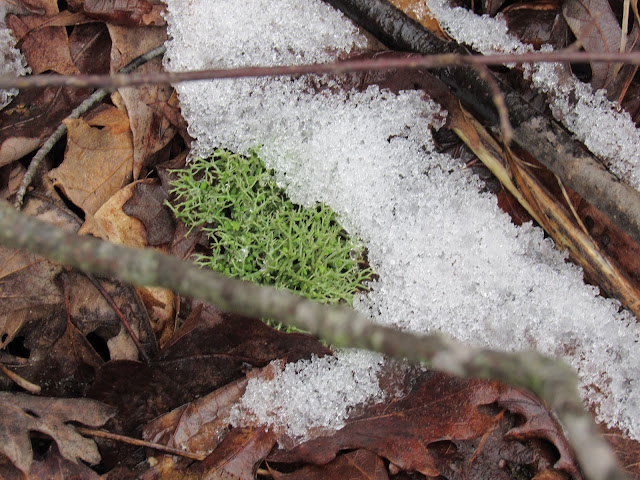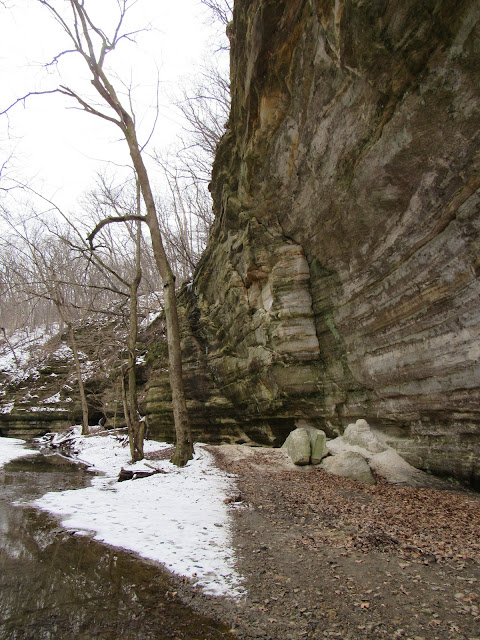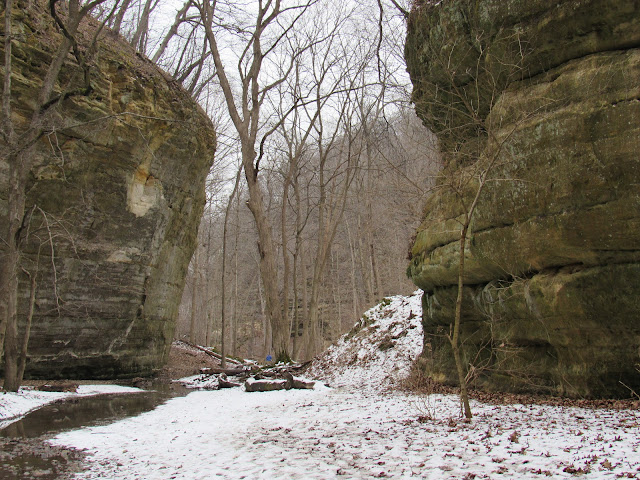The recent snowfall suited the canyon well, as we walked into the last hike of the day. I promised that we found something here that not even the IDNR resident at the park knew about, and this is true. Guess what, it's an Eastern Hemlock (Tsuga canadensis):
A single, twenty-foot tall hemlock tree grew in Kaskaskia Canyon. This is the only wild Eastern Hemlock I have seen outside St. Louis Canyon.
However, Kaskaskia Canyon is most famous for a massive shelter bluff, seen above. It's hard to appreciate exactly how big this bluff is, but it is probably 40-50 feet tall and about 100 feet wide. The dark stain on the back of this bluff was made by Native American campfires. Facing southeast, this bluff provides the ideal location for a residence, as it is near a stream, out of the wind, and large enough for a few families to live under it. There is a history of human habitation here that stretches back thousands of years.
A few small icicles clung to the edge of the rock. This area was full of icicles, some of the largest I have ever seen.
The few green plants, such as the hemlock, stood out boldly in contrast to the rest of the canyon.
On the ground nearby, a few tufts of foliose lichen had fallen from the canyon walls. Foliose lichens are one of several signs of a high-quality natural area, especially in this state.
The rocks nearby were really quite uniquely shaped. This shelter bluff reminded me of a bridge, waiting to be fully carved out of the rock.
On average, the bluffs were 40-50 feet high, occasionally higher.
Here, the dripline, where the stone overhangs prevent moisture from reaching further inwards, are very clearly seen. Almost no plants grow nearer to the cliff than the dripline, as the dry, sandy, permanently shaded region at the base of the cliff is nearly impossible to grow in.
Does this not remind you of a tongue sticking out?
Here, one gets a sense of scale. This place was huge.
Here's the waterfall at the back of Kaskaskia Canyon. It's one of the shorter waterfalls.
Ice has formed on the downed trees, right next to the waterfall. While the water is warmer than freezing, the air isn't.
Can you spot the man in the blue jacket?
As usual, there were mysterious plants. This vaguely resembles Hieracum or Krigia, and i'd tend to guess the former, as it was growing on a sandstone ledge. All around it grew liverworts (Marchantia spp.), an uncommon type of nonvascular plant. When I say uncommon, I mean in the wild in Illinois in general, not at Starved Rock specifically. As liverworts prefer constant moisture and rocky surfaces, they are common in the park's canyons.
Here's the "tongue" of ice seen earlier. It appears that some passerby has knocked the bottom off this large icicle, giving it this shape. The snow and ice made the canyon far more beautiful this time of year than usual.
Here, you can see the way that the stone walls of the canyon make it feel less like a "box" canyon and more like a "trapezoid" canyon. (If you haven't had geometry in a long time, just use Google.) This is, I think, one of my best pictures of Starved Rock that I have taken.
Here, another unknown plant, likely Geranium, Hydrophyllum, or Phacelia, pushes up from the leaves.
Despite the snow, spring is certainly coming, as the emergent leaves of Spring Beauty (Claytonia virginica) show here. In southern Illinois on the warm blufftops of Pere Marquette State Park, this species is already in flower.
The thick sheets of moss growing on the side of the cliffs demonstrates how wet the area is. This species of moss might possibly be a clubmoss, as it appears to have short stems. As I do not know this for certain, I cannot say as such.
The rock here almost seems to have flowed around the tree on the left.
Ottawa Canyon is a side branch of Kaskaskia Canyon. It winds its way back to a taller but equally cool waterfall. (Pun completely intended.)
I could spend an entire month here just examining the differing kinds of moss.
We reached the back of Ottawa Canyon. For a sense of perspective, this waterfall is about thirty feet tall.
The ice here was some of the most spectacular yet. The small trickle of water had, over the last few weeks, formed a strange lower ice sculpture at its base.
Here, the splash pool of the waterfall was partially frozen over, unlike Kaskaskia Canyon.
This unique natural ice sculpture was likely the base of a former icefall which had vanished in the freezing and thawing of late winter. It was about fifteen feet wide.
A few icicles had frozen over at the edge of the fall. A secondary icefall had also formed. I wonder, now, how much of that had disappeared of the course of this week? I do know that the waterfalls are probably flowing better after this week's rains.
The man in the center left of the picture is about six feet tall, for scale. The grey stone and the white slope were such a stunning contrast.
Two bluffs formed a natural narrows of Ottawa Canyon at its entrance.
As we walked out of the canyon, we saw this. These old shelf fungi are not naturally green. Instead, algae have grown on top, due to the moisture of the melting snow. Below is the entrance of Kaskaskia Canyon.
This was the last hike in the March 2016 Starved Rock Expedition. I have just learned that a rare orchid, the Spring Coral-Root Orchid (Corallorhiza wisteriana), dwells in the sandy moss beds in St. Louis Canyon. There is an expedition in the works for May to see this remarkable plant, which grows without ever using leaves and generally is ignored by the majority of people as looking like a stick. Spring is nearly here. and it's about time. I'm tired of winter, and as I've made it a goal to see orchids this spring, I darn well better live up to that goal.
History Fact:
President Teddy Roosevelt went on a Amazon expedition after his Presidency and nearly died of bacterial infection. The infection, while he recovered somewhat from it, ruined his health and cost him any further attempts at the Presidency. He died less than five years later.

































No comments:
Post a Comment